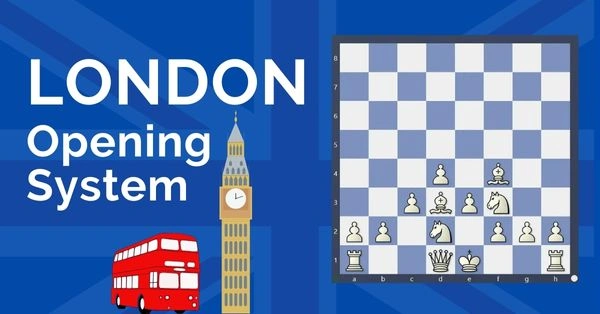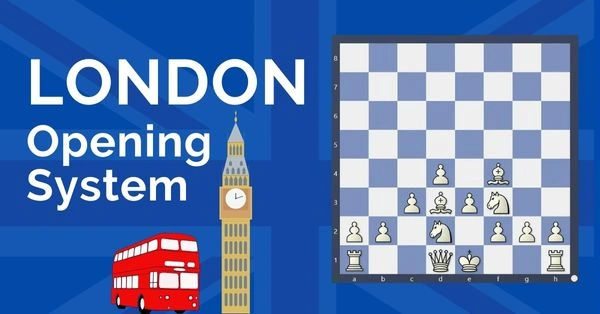

London System is one of the easiest openings to learn and one of the hardest openings to face.
It makes it popular among beginners as well as among strong players and top grandmasters.
It is based on a simple scheme of development that can be used against any Black setup.
This is why it is considered a system, although many people call it the London Opening.
London Opening: What is it?
There are many ways to reach the London setup. The most usual one is to start the game with 1.d4 and then, go 2.Bf4 or 2.Nf3, followed by 3.Bf4. In the diagram below, you can see the main scheme of development for White:

Black can place their pieces differently, but White’s setup will still work.
Why Play The London System
If you are a beginner, you may enjoy the following aspects of the London:
- It’s easy to remember and can be played against everything;
- Your pieces are well-placed. White gets great control over the center and has no weaknesses.
- Your position will be solid. All the pieces are usually protected, which makes blunders less probable.
If you are a club player or even stronger, there are the following great things about the London for you:
- You save time on preparation, by avoiding complicated mainstream theory;
- You get solid positions with chances to attack the opponent king;
- You get out of the opening safely and save time on the clock.
How to play London System: Popular Variations
White’s Ideal Set-Up
Quite often White gets a promising position in the London thanks to the difference in the strength of the light-squared bishops. Let’s look at the following position:

White’s bishop on d3 is powerful; it is targeting the vulnerable pawn on h7. The typical maneuver to remember here is Qd1-f3-h3. After that, Black’s king will be under big pressure. Black’s light-squared bishop, on the other hand, is locked up and can’t participate in the game.
Another central idea for White is to use the e5-square as an outpost for the knight. If Black trades on e5, White often takes back with a pawn. That will force the f6-knight away from defending the king and allow White to develop a strong attack against the h7-pawn.
Black’s ideas
What can Black try against the London System? One of the most typical ideas is to attack the pawn on b2 with …Qb6.

This idea of developing the queen to b6 can be played under different circumstances. Based on that, White can choose how to protect the pawn. The most common way to counter …Qb6 is with Qb3. Playing b2-b3 is rarely a good idea because it creates many weaknesses on the queenside for White.
Another typical idea is to trade the light-squared bishops via a6.

This way Black makes sure White’s attack won’t be dangerous. Later, Black will hit the center with …c7-c5. It was also possible to develop the bishop on b7, supporting the future …Ne4 (e4 is a great outpost for the knight).
Move Order Tricks
The most natural move order to reach the London System is 1.d4 d5 2.Nf3 Nf6 3.Bf4 c5 4.e3 Nc6 5.c3.

White is ready to play Nbd2, Bd3, and Ne5. Yet, Black can start showing activity first: 5…Qb6 6.Qb3 c4! 7.Qc2 Bf5!

An important tactical trick! Taking the bishop loses to 8…Qxb2. Now White should play 8.Qc1 and remain a bit passive. Going into the endgame earlier with 7.Qxb6 also wasn’t a pleasant option for White.
That is why a more popular London move order is 1.d4 d5 2.Bf4 Nf6 3.e3 c5 4.c3 Nc3 5.Nd2:

Now after 5…Qb6 6.Qb3 c4 7.Qc2, there is no 7…Bf5. Next, White will continue according to the scheme.
Another popular move order of the London System is 1.d4 d5 2.Nf3 Nf6 3.Bf4 c5 4.e3 Nc6 5.Nbd2. You can investigate it if you prefer more complicated positions.
Main Line Variation
The main line of the London System is characterized by Black’s attempt to trade the dark-squared bishops on d6. For example, 1.d4 d5 2.Bf4 Nf6 3.e3 e6 4.Nf3 Bd6:

White has three main plans: 5.Bg3, 5.Ne5, and 5.Nbd2.
The most common move is 5.Bg3. White is hoping for an attack on the h-file after the potential trade on g3. Black can play 5…0-0 6.Nbd2 c5 7.c3 Nc6 8.Bd3.

Black usually continues with …b6 and …Bb7. White can choose between playing for Qe2, followed by e3-e4, and Ne5, followed by f2-f4.
Black can also place the knight on d7 instead of c6. 7…Qc7 8.Bd3 Nbd7. Next, Black can play …b6 and …Bb7 or break in the center with …e6-e5. This is one of the best setups against the London System.
Black Copies White
We saw that the common issue for Black in the London System was the passive light-squared bishop. Therefore, it is logical to try to develop it more actively early on. For example, 1.d4 d5 2.Bf4 Nf6 3.e3 Bf5 4.Nf3 e6:

The position is symmetrical, but White can start fighting for the initiative first. The traditional way is to go for c2-c4, followed by Qb3. Another common idea is to simply trade the bishops on d3 and castle.
The Jobava London
Another popular setup for White is the Jobava London System. It is also often referred to as the Jobava-Rapport System. It is characterized by the development of the queenside knight to c3 and the bishop to f4: 1.d4 d5 2.Nc3 Nf6 3.Bf4.

One of the ideas for White is to jump with the knight to b5 in order to disorganize Black’s development. The other commonplace is to grab space on the kingside with the g-pawn. It is especially effective if Black develops the bishop on f5.
Against the King’s Indian Defense
Let’s see if you can play the London System against the King’s Indian Defense. 1.d4 Nf6 2.Bf4 g6 3.Nf3 Bg7 4.e3 0-0 5.Be2 d6

White develops in a regular fashion and gets a safe and flexible position. Note that the light-squared bishop is better placed on e2 than on d3 against Black’s kingside fianchetto. On d3 it would get blocked by Black’s pawn and also vulnerable to a potential pawn fork …e5-e4. Overall, Black players can opt for the double fianchetto or play for …c7-c5 or …e7-e5 pawn breaks, but there won’t be the exciting kingside attacks they usually look for in the King’s Indian.
Queen’s Indian
It is impossible to play the Nimzo-Indian against the London (any …Bb4+ would simply be met with c2-c3). But Black can play the Queen’s Indian setup. It shouldn’t worry us, the London is still a good option against it. Let’s look at the diagram:

The main difference is the placement of Black’s d-pawn. Usually, it goes to d6 to stop any Ne5 ideas for White. On the other hand, now White can push e3-e4 at an appropriate moment. The plan with a2-a4-a5 is also possible.
Stonewall Variation
The Stonewall setup is characterized by the pawn formation c6-d5-e6-f5. The drawback of this setup is the weakened e5 square. In the London System, White tries to control this square the most. So we can conclude that the London setup should work very well against the Stonewall.

White controls the center well and can play in the Queen’s Gambit style with c4, Nc3 and Rc1.
Chess Courses on the London System in TCW Store
Interested in studying all the details of the London Opening? You might want to learn from an experienced coach GM Damian Lemos. In his great course, he walks you through all the popular Black’s replies and gives you a complete 1.d4 repertoire based on the London System. You will not only learn the opening but also improve your general chess understanding.
If you are an aggressive player, check out an awesome course by GM Miloje Ratkovic. It will teach you a lot of fresh attacking ideas to shock your opponents. No boring or dull positions at all!
FAQ About London Opening
#1 How to refute the London System?
The London System is a completely sound opening. White develops pieces on good squares and doesn’t break any opening rules. Therefore, it can’t be refuted. Black has different tries to pose practical problems, but if White plays precisely, the game should be at least balanced.
#2 Do grandmasters play the London System?
Yes! The London System used to live in the shadows of the Queen’s Gambit, but nowadays many top grandmasters play it frequently. Ding Liren used the London System to beat Ian Nepomniachtchi in Game 6 of the World Chess Championship match 2023. Magnus Carlsen plays it a lot as well.
#3 Is the London System an opening for lazy players?
The London System is a great opening for lazy players, but it also can be played ambitiously. There are many nuances, move orders and different ideas. That’s why even grandmasters find it hard to play against a strong London System player.
#4 Is the London System better than the Trompowsky Attack?
Both openings are great. Many people combine the two and answer 1.d4 Nf6 with 2.Bg5 (the Trompowsky) and 1.d4 d5 with 2.Bf4 (the London) to form a complete repertoire.
#5 I love the London System for White. Are there similar openings for Black?
Yes, you can try to play the Caro-Kann and the Slav Defense. These openings lead to similar pawn structures to the London System.
Discover more from reviewer4you.com
Subscribe to get the latest posts to your email.


![Beat The King’s Gambit As Black [Falkbeer Countergambit]](https://reviewer4you.com/wp-content/uploads/2024/11/Destroying-Whites-Highest-Win-Rate-Opening-As-Black.webp-336x220.webp)


